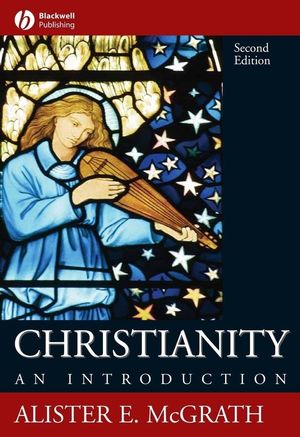Christianity: An Introduction, 2nd EditionISBN: 978-1-4051-0901-7
Hardcover
400 pages
February 2006, Wiley-Blackwell
 This is a Print-on-Demand title. It will be printed specifically to fill your order. Please allow an additional 10-15 days delivery time. The book is not returnable.
Other Available Formats: Paperback
|
||||||
Encountering Christianity: Some Gateways.
Texts.
Services.
Buildings.
Music.
Art.
Poetry.
1. Jesus of Nazareth.
The centrality of Jesus to the Christian faith.
The gospels and Jesus.
Jesus and Roman historians.
Jesus and Israel.
Jesus and Jewish Groups.
The Birth of Jesus.
The Beginning of the Public Ministry of Jesus.
Jesus and Women.
The Teaching of Jesus: The Parables of the Kingdom.
The Crucifixion.
The Resurrection.
Events and Meanings.
The New Testament Understandings of Jesus.
Messiah.
Lord.
Saviour.
Son of Man.
Son of God.
God.
2. Introducing the Bible.
The Bible: The Origin of the Term.
The Continuity between Old and New Testaments.
The Contents of the Bible.
The Translation of the Bible.
The Interpretation of the Bible.
The Devotional Reading of the Bible: Christian Spirituality.
3. The Old Testament.
The Shape of the Old Testament.
The Contents of the Old Testament.
The Five Books of the Law.
The Historical Books.
The Writings.
The Prophets.
Major Themes of the Old Testament.
The Creation.
Abraham: Calling and Covenant.
The Exodus from Egypt and Giving of the Law.
The Entry into the Promised Land.
The Establishment of the Monarchy.
The Priesthood.
Prophecy.
The Exile.
The Restoration.
4. The New Testament.
The Gospels.
The period of oral tradition.
Matthew.
Mark.
Luke.
John.
The Synoptic Problem.
Acts.
The Letters.
The Letters of Paul.
The Letters of Peter.
The Letters of John.
Other Letters.
The Book of Revelation.
5. The background to Christian belief.
What is faith?.
Proofs of God’s existence?.
The sources of Christian beliefs.
The Bible.
Tradition.
Creeds.
Reason.
The ‘Handmaid’: dialogue between theology and culture.
What is theology?.
6. A Brief Outline of Core Christian Beliefs.
God.
God as father.
A personal God.
God as almighty.
The Trinity.
Creation.
Models of creation.
Implications of the Doctrine of Creation.
Models of God as Creator.
Creation and natural theology.
Humanity.
Humanity and the ‘image of God’.
Humanity, the fall, and sin.
Jesus.
Islamic approaches to the identity of Jesus.
Early Christian approaches to Christology.
The concept of the incarnation.
Jesus as mediator.
Salvation.
Christ the Victor: The defeat of death and sin.
Christ the Harrower of Hell: Atonement and restoration.
Christ the Redeemer: Atonement as satisfaction.
Christ the Lover: Atonement and the enkindling of love.
Grace.
The Church.
The unity of the church.
The universality of the church.
The holiness of the church.
The sacraments.
What is a sacrament?.
Baptism.
Eucharist.
Christianity and other faiths.
The ‘common sense’ approach to other religions.
The pluralist approach.
The particularist approach.
The inclusivist approach.
The last things: heaven.
7. A brief history of Christianity.
The early church.
Christianity and Judaism.
Christianity and women.
The Expansion of the Gospel: Paul.
The Expansion of the Gospel: Rome.
The Consolidation of Christianity.
Theological debates of the early Christian period.
The Origins of Monasticism.
The Rise of Celtic Christianity.
The Middle Ages.
Instability: the church in a period of uncertainty.
Christianity in the East to the fall of Constantinople.
The renewal of western Christianity.
The rise of Scholasticism.
The rise of the Religious Orders.
The rebirth of western culture: the Renaissance.
Western Christianity in the Late Middle Ages.
The growth in adult literary.
A surge in anti-clericalism.
The rise in doctrinal pluralism.
The Reformation.
The Lutheran Reformation.
The Calvinist Reformation.
The Radical Reformation (Anabaptism).
The Catholic Reformation.
The Rise of Protestantism.
The Reformation in England.
The leading features of Protestantism.
The Confessionalization of faith: Protestant Orthodoxy.
English-language Protestantism: Puritanism.
A Protestant religion of the heart: Pietism.
The Great Awakening: American Protestantism.
The resurgence of Roman Catholicism.
The Council of Trent.
The Society of Jesus.
The renewal of Catholic spirituality.
The wars of religion.
The modern period.
The rise of indifference to religion in Europe.
The Enlightenment: the rise of rationalism.
Christianity in the American Revolution.
The great revolt against God: the origins of western atheism.
Karl Marx and the consolidation of atheism.
The globalization of Christianity: The Age of Mission.
The shifting fortunes of Roman Catholicism.
The First Vatican Council.
The Victorian crisis of faith.
The Armenian Genocide of 1915.
The Russian Revolution and the State enforcement of Atheism.
The Nazi Crisis: The Failure of ‘Culture Protestantism’.
The Second Vatican Council.
8. Christianity: A Global View.
A Regional Survey of Christianity.
Africa.
South-East Asia.
North America.
South America.
Europe.
Christianity: A Survey of its contemporary forms.
Roman Catholicism.
Eastern Orthodoxy.
Pentecostalism.
Protestantism.
Anglicans.
Baptists.
Lutherans.
Methodists.
Presbyterians and other Reformed Christians.
Evangelicalism.
Christianity: A Survey of its Global Concerns.
The globalization of Christianity.
The challenge of fundamentalism.
Tensions between Christianity and Islam.
The uncertain future of the Protestant denomination.
The commodification of Christianity in the west.
The demands for de-westernization of Christianity.
The emergence of new ways of ‘being church’.
9. The life of faith: Encountering Christianity as a lived reality.
The life of the church.
Christian Weddings.
Christian Funerals.
The Service of Nine Lessons and Carols.
Christian Worship.
Prayer.
Praise.
Reading Scripture.
Preaching.
The Reciting of the Creeds.
The Sacraments.
Baptism.
Eucharist.
The rhythms and seasons of the Christian life.
The Christian Year.
Advent.
Christmas.
Epiphany.
Lent.
Easter.
Ascension.
Pentecost.
Trinity.
The monastic day.
Christian Attitudes to Culture: Some General Considerations.
The Impact of Christianity on Culture.
Christianity and the Development of the Natural Sciences.
Christian symbolism: the cross.
Christian art.
Church architecture.
Stained glass.
Icons.
Christian music.
Christianity and Literature.
Pilgrimage and the Christian life.
For further reading.
A Glossary of Christian terms.
Index



